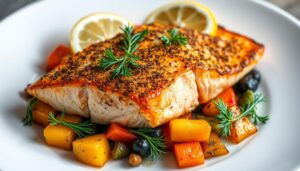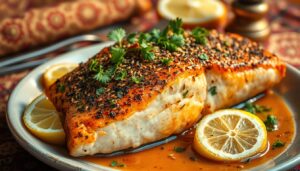Are you ready to discover the ultimate chicken dressing recipe that will transform your holiday meals? At Luyarecipes.com, we’re passionate about bringing you authentic traditional chicken dressing that captures the heart of American home cooking. This beloved side dish has been warming tables across the United States for generations, offering a delicious blend of comfort and flavor.
A traditional chicken dressing recipe isn’t just a simple side dish—it’s a culinary tradition that connects families and creates lasting memories. Whether you’re preparing for Thanksgiving, a Sunday family dinner, or simply craving a taste of home, this chicken dressing recipe will become your go-to comfort food.
Chicken dressing represents more than just a recipe. It’s a celebration of regional cooking techniques, family traditions, and the art of transforming simple ingredients into something extraordinary. Each bite tells a story of culinary heritage passed down through generations.
Key Takeaways
- Learn the authentic traditional chicken dressing technique
- Understand the cultural significance of chicken dressing
- Discover how to create a perfect texture and flavor
- Master a versatile recipe suitable for multiple occasions
- Explore the rich culinary history behind this classic dish
Understanding the Basics of Traditional Chicken Dressing
Chicken dressing represents a cherished culinary tradition deeply rooted in American home cooking. This beloved dish has transformed from a simple side to a centerpiece of family gatherings, particularly during holiday meals.
The journey of homemade chicken dressing spans generations, reflecting the diverse cultural influences that shape American cuisine. Each region brings its unique twist to this classic chicken dressing, creating a rich tapestry of flavors and techniques.
Culinary Roots in American Cuisine
Traditional chicken dressing emerged from resourceful home cooks who wanted to transform simple ingredients into hearty meals. Settlers learned to combine bread, herbs, and available proteins to create satisfying dishes that could feed large families.
“A good chicken dressing tells a story of family, tradition, and culinary creativity.” – Southern Cooking Magazine
Essential Components of Classic Chicken Dressing
Creating an authentic homemade chicken dressing requires understanding key ingredients. Bread forms the foundation, with cornbread, white bread, or sourdough serving as popular bases. Herbs like sage, thyme, and parsley add depth, while onions and celery provide aromatic complexity.
Regional Flavor Variations
Different regions showcase unique approaches to chicken dressing. Southern recipes often include cornbread and oysters, while Midwestern versions might incorporate wild rice or sausage. These variations highlight the dish’s adaptability and cultural significance across the United States.
Essential Ingredients for the Perfect Chicken Dressing Recipe
Creating an easy chicken dressing starts with selecting the right ingredients. Your culinary success depends on choosing high-quality components that work together harmoniously. Fresh bread serves as the foundation of any great dressing, with day-old or slightly stale bread providing the best texture.
Your best chicken dressing will require several key ingredients. Opt for a good-quality white or sourdough bread, which can be cubed and dried to create the perfect base. Fresh herbs like sage, thyme, and rosemary will elevate the flavor profile. You’ll want to include chicken or turkey stock for moisture, along with beaten eggs to bind the ingredients.
“The secret to an incredible dressing is using fresh, high-quality ingredients and balancing flavors carefully.” – Professional Chef
Essential ingredients include:
– Dried bread cubes
– Butter or olive oil
– Chopped onions
– Celery
– Fresh herbs
– Chicken stock
– Eggs
– Salt and pepper
For those with dietary restrictions, you can easily modify the easy chicken dressing recipe. Gluten-free bread works wonderfully, and vegetable stock can replace chicken stock. Experiment with different herbs and seasonings to create a unique flavor that suits your taste preferences.
Kitchen Tools and Equipment You’ll Need
Preparing a delicious chicken dressing requires the right tools and equipment. Having the proper kitchen gear can transform your cooking experience and help you create a truly flavorful chicken dressing that will impress your family and friends.

Your kitchen arsenal will make preparing chicken dressing much easier and more enjoyable. From mixing to baking, each tool plays a crucial role in creating a perfect dish.
Essential Utensils for Chicken Dressing Preparation
Start with basic tools that every home cook should have. A large mixing bowl helps combine ingredients smoothly. Sharp chef’s knives are critical for chopping herbs and vegetables. Measuring cups and spoons ensure precise ingredient quantities for your delicious chicken dressing.
Optional Equipment for Enhanced Convenience
Some additional tools can streamline your cooking process. A food processor can quickly chop ingredients, while a stand mixer makes blending easier. A kitchen scale provides extra precision for measuring ingredients.
Selecting the Perfect Baking Dish
Choosing the right baking dish matters for your flavorful chicken dressing. Ceramic and glass dishes distribute heat evenly. A 9×13 inch rectangular dish works best for most recipes. Look for dishes with high sides to prevent overflow and ensure even cooking.
“The right tools can turn a good recipe into a great meal.” – Professional Chef
Step-by-Step Preparation Guide
Creating the perfect chicken dressing recipe starts with careful preparation. Your journey begins by gathering all ingredients and tools needed for this delicious dish. An easy chicken dressing requires attention to detail and a systematic approach.
First, prepare your bread by cutting it into small, uniform cubes. Day-old bread works best for achieving the ideal texture. Spread the bread cubes on a baking sheet and toast them lightly in the oven until they’re golden and crisp. This step ensures your dressing maintains a delightful crunch.
“The secret to an amazing chicken dressing is in the bread preparation.” – Chef Maria Rodriguez
Next, chop your herbs and vegetables with precision. Finely diced onions, celery, and fresh sage will infuse your chicken dressing recipe with rich, aromatic flavors. Sauté these ingredients in butter until they’re soft and fragrant, releasing their natural oils and enhancing the overall taste.
Combine your toasted bread cubes with the sautéed vegetables, adding chicken broth, eggs, and seasonings. Mix gently to ensure even distribution of ingredients. Transfer the mixture to a prepared baking dish, spreading it evenly for consistent cooking.
Bake your easy chicken dressing in a preheated oven at 350°F for approximately 45 minutes. Watch for a golden-brown top and crispy edges, which indicate your dressing is perfectly cooked and ready to serve.
Tips for Achieving the Perfect Texture
Creating the best chicken dressing requires mastering a few key techniques that transform ordinary ingredients into a memorable dish. Texture plays a crucial role in elevating your savory chicken dressing from good to extraordinary.
Getting the right moisture balance is critical for an exceptional dressing. Too dry, and your dish becomes crumbly and unappetizing. Too wet, and it turns into a soggy mess. The secret lies in careful preparation and precise ingredient management.
Bread Selection and Preparation
Choosing the right bread forms the foundation of your savory chicken dressing. Day-old bread works best, as slightly stale bread absorbs flavors more effectively. Cut bread into uniform cubes and allow them to dry out overnight on a baking sheet. This technique ensures your best chicken dressing maintains a perfect texture.
Moisture Control Techniques
Control moisture by adding chicken broth gradually. Start with small amounts and mix thoroughly. Your goal is a consistency that’s moist but not saturated. A good rule of thumb is to stop adding liquid when the bread appears evenly coated but not swimming.
Proper Mixing Methods
When combining ingredients, use a gentle folding technique. Overmixing can break down bread cubes, creating a dense, compact dressing. Soft, careful mixing preserves the bread’s structure and ensures a light, appetizing result.
“The difference between a good and great dressing is in the details of preparation.” – Professional Chef
Common Mistakes to Avoid When Making Chicken Dressing

Creating the perfect homemade chicken dressing can be tricky. Many home cooks stumble into common pitfalls that can turn this classic dish into a culinary disappointment. Understanding these potential errors will help you craft a delicious traditional chicken dressing that will impress your family and friends.
One of the most frequent mistakes is using bread that’s too fresh. Stale or day-old bread works best for homemade chicken dressing. Fresh bread can become mushy and destroy the ideal texture. Cube your bread and let it sit out for a day to dry slightly before mixing with other ingredients.
“The secret to great chicken dressing is in the details and preparation.” – Southern Cooking Experts
Seasoning is another critical area where many cooks go wrong. Too much salt can ruin your traditional chicken dressing, while too little leaves it bland. Always taste your mixture before baking and adjust seasonings carefully. Use herbs like sage and thyme sparingly – they should complement, not overwhelm.
Moisture control is crucial in achieving the perfect dressing consistency. Avoid adding too much liquid, which can make your dish soggy. Start with less broth and add gradually. If your dressing seems dry, you can always add more liquid during mixing.
Lastly, pay attention to baking time and temperature. Overcooking leads to dry, crumbly dressing, while undercooking results in a mushy texture. Aim for a golden-brown top and a moist interior. Use a thermometer to ensure your dressing reaches a safe internal temperature.
Storage and Reheating Guidelines
After preparing your delicious chicken dressing recipe, knowing how to store and reheat it properly can help maintain its incredible flavor and texture. Proper storage techniques will ensure your chicken dressing remains appetizing and safe to enjoy for several days.
Storing your homemade chicken dressing correctly is crucial to preserving its taste and preventing food spoilage. Always use airtight containers when refrigerating your dressing. Freshly prepared chicken dressing can be safely stored in the refrigerator for up to 3-4 days.
Refrigeration Best Practices
Cool your chicken dressing completely before storing it in the refrigerator. Use shallow containers to help the dressing cool faster and prevent bacterial growth. When properly stored, your delicious chicken dressing will maintain its original taste and texture.
Reheating Techniques
Reheating chicken dressing requires careful attention to prevent drying out. The oven method works best for maintaining moisture. Preheat your oven to 350°F, cover the dressing with aluminum foil, and heat for about 15-20 minutes. Add a splash of chicken broth to keep it moist if needed.
Freezing Your Dressing
You can freeze your chicken dressing recipe for up to one month. Wrap it tightly in freezer-safe containers or heavy-duty aluminum foil. When ready to eat, thaw in the refrigerator overnight and reheat thoroughly before serving.
“Proper storage is the secret to enjoying delicious chicken dressing days after preparation!” – Culinary Chef
Variations and Creative Twists
Exploring different takes on classic chicken dressing can transform your holiday meal from ordinary to extraordinary. Your flavorful chicken dressing doesn’t have to follow a strict traditional recipe. Instead, you can experiment with exciting ingredients that bring new life to this beloved dish.
“Creativity in cooking is about respecting tradition while daring to innovate.” – Julia Child
Regional variations offer unique flavor profiles for your classic chicken dressing. Southern-style recipes might include cornbread, while New England versions could incorporate oysters. Consider adding dried cranberries for a tangy twist or toasted pecans for unexpected crunch. These small modifications can elevate your chicken dressing from good to unforgettable.
Dietary needs don’t have to limit your culinary creativity. Gluten-free options can use gluten-free bread or cornbread. Vegetarian versions might substitute chicken broth with vegetable stock and add hearty mushrooms for depth. Quinoa or wild rice can replace traditional bread for a protein-packed alternative that still captures the essence of a flavorful chicken dressing.
For those seeking bolder flavors, try incorporating herbs like sage, thyme, or rosemary. Chorizo or andouille sausage can add a spicy kick to your classic chicken dressing. Apple and sage combinations bring a sweet and earthy dimension that will surprise and delight your dinner guests.
Conclusion
Crafting the perfect savory chicken dressing is an art that combines tradition with personal creativity. Your journey through this recipe has equipped you with essential techniques and insights to create a delectable side dish that will impress family and friends at any gathering.
Remember that each chicken dressing recipe is unique. The key is to experiment with ingredients, embrace regional variations, and develop your signature touch. Whether you’re preparing a classic Southern-style dressing or exploring innovative twists, your confidence in the kitchen will grow with every attempt.
We invite you to explore more culinary adventures by visiting luyarecipes.com and checking out our Pinterest account at pinterest.com/luyarecipes/. Share your savory chicken dressing creations, learn from other home cooks, and continue expanding your cooking skills. Your dedication to perfecting this timeless recipe will bring warmth and joy to your dining table.
Happy cooking, and may your chicken dressing always be a crowd-pleasing centerpiece of delicious meals!
FAQ
What is the difference between stuffing and dressing?
The main difference is that stuffing is cooked inside the cavity of a turkey or chicken, while dressing is baked separately in a baking dish. Traditionally, southern recipes tend to use the term “dressing,” while northern recipes often call it “stuffing.” Both are typically made with similar ingredients like bread, herbs, and seasonings.
Can I make chicken dressing ahead of time?
Yes, you can prepare chicken dressing in advance. You can assemble the dressing up to 24 hours before baking and store it covered in the refrigerator. This can be a great time-saving strategy for holiday meals or large gatherings. Just be sure to add a few extra minutes to the baking time if you’re cooking it directly from the refrigerator.
How do I prevent my chicken dressing from becoming too dry?
To keep your chicken dressing moist, use plenty of liquid such as chicken broth or stock when mixing the ingredients. Cover the dressing with foil while baking for the first part of the cooking time, and only uncover it for the last 15-20 minutes to crisp the top. Adding beaten eggs can also help create a more custardy, moist texture.
Can I make a gluten-free chicken dressing?
Absolutely! Simply substitute regular bread with gluten-free bread or cornbread. You’ll want to use gluten-free breadcrumbs or cubes and ensure that all other ingredients like broth and seasonings are also gluten-free. Many grocery stores now offer excellent gluten-free bread options that work perfectly in dressing recipes.
How long can I store leftover chicken dressing?
Leftover chicken dressing can be stored in an airtight container in the refrigerator for 3-4 days. When reheating, add a little extra broth to maintain moisture and heat in the oven at 350°F until warmed through, typically about 15-20 minutes. For best quality, consume within 3 days of preparation.
What are some creative variations of chicken dressing?
There are many delicious variations you can try! Consider adding ingredients like chopped apples and sage for a sweet-savory twist, incorporating sausage for extra richness, using cornbread as a base, or adding dried cranberries and pecans for a festive flavor. You can also experiment with different herbs like thyme, rosemary, or marjoram to create unique flavor profiles.
Is chicken dressing a healthy side dish?
Chicken dressing can be relatively high in calories and carbohydrates, but you can make healthier versions by using whole grain bread, adding more vegetables, reducing butter, and using low-sodium broth. Portion control is key. You can also incorporate nutrient-rich ingredients like celery, onions, and herbs to boost the nutritional value.
Can I freeze chicken dressing?
Yes, chicken dressing freezes quite well. Allow it to cool completely, then store in an airtight container or freezer-safe bag for up to 1 month. When ready to eat, thaw in the refrigerator overnight and reheat in the oven at 350°F, adding a little extra broth to restore moisture.









